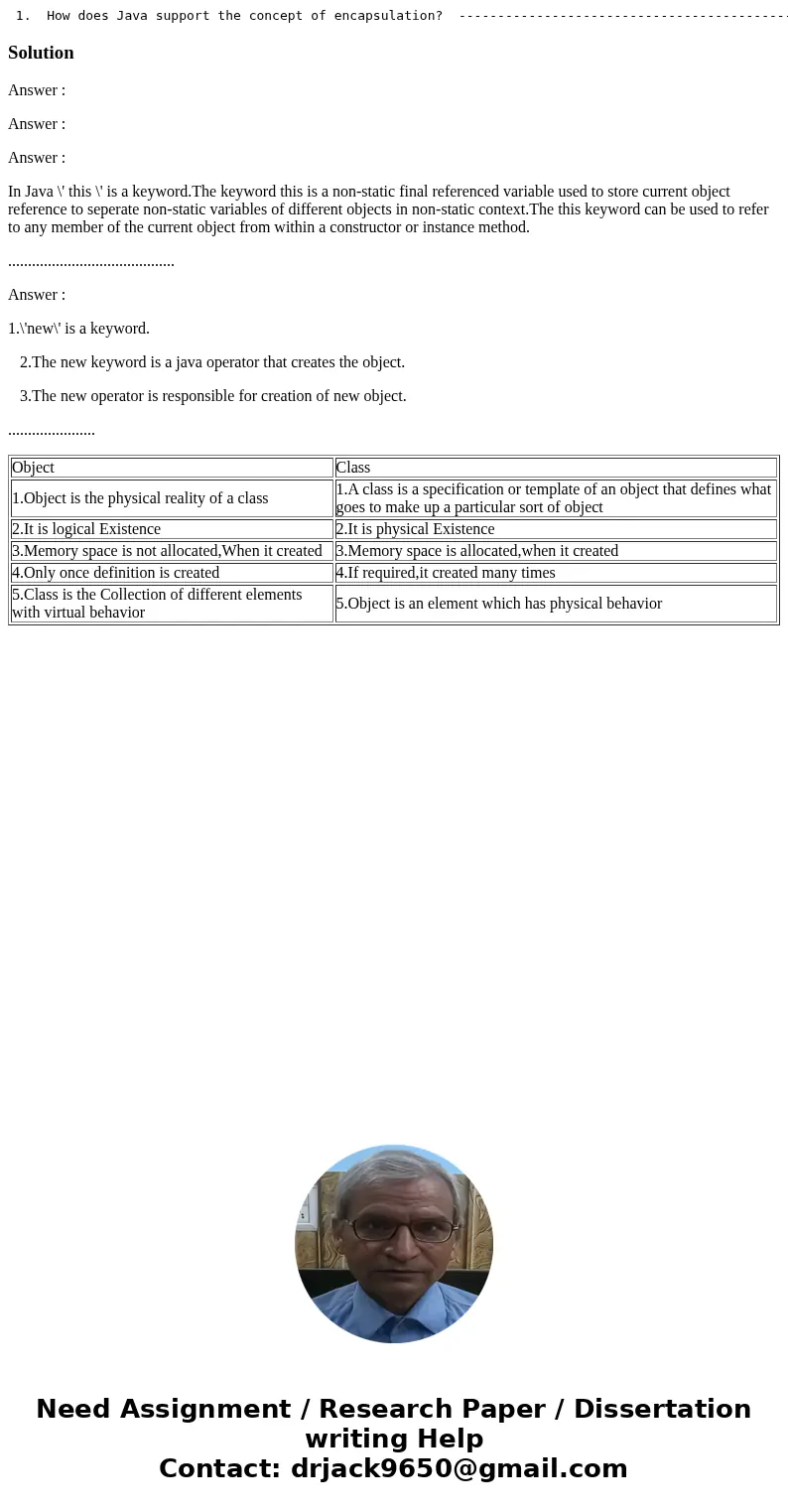1 How does Java support the concept of encapsulation 2 Desc
1. How does Java support the concept of encapsulation? -------------------------------------------------------------------- 2. Describe the difference between an object and a class. -------------------------------------------------------------------- 3. What is the difference between the contents of a Java variable of a primitive type and a Java variable of a class type? -------------------------------------------------------------------- 4. (a) How is a \'static\' class method different from a regular (non-static) class method? (b) How is a \'static\' variable in a class different from a regular (instance) variable in a class? -------------------------------------------------------------------- 5. What does the Java keyword \'this\' refer to? -------------------------------------------------------------------- 6. What does the Java \'new\' operator do? -------------------------------------------------------------------- 7. When does a class require an \'equals\' method to be written? -------------------------------------------------------------------- 8. What is method \"overriding\"? Why would you override a method? -------------------------------------------------------------------- 9. What advantages does inheritance provide in Java? -------------------------------------------------------------------- 10. What is dynamic binding? What advantage does it provide? -------------------------------------------------------------------- 11. How is it possible for two String objects with identical values not to be equal when compared with the == operator? -------------------------------------------------------------------- 12. Why can a class variable of a base type be set to reference an object of a derived type, eg: Shape s = new Circle(\"Blue\", 1.0); -------------------------------------------------------------------- 13. How can the methods of a derived class access private instance variables of its base class? -------------------------------------------------------------------- 14. The following try/catch has code to explicitly handle any IllegalArgumentException thrown. Show the modified code that will also catch any other type of exception that could be thrown by code called within the try block. try { ... methods called here ... ... } catch (IllegalArgumentException e) { ... code to handle IllegalArgumentException ... } -------------------------------------------------------------------- 15. How is the caller\'s flow of control (sequence of statement execution) different when an exception is thrown from a method that it calls, vs. when the method returns normally? ------------------------------------------------------------------- The following questions are 20 points each. Paste your source code below each question, and example input and output. Do not include the code required to test the methods, etc. -------------------------------------------------------------------- P1. Write a static method that checks if a String represents a valid integer value and returns true if valid, or false if not. For example, \"123\", \"-45\", and \"0\" are valid integers, but \"x7\" and \"3.14\" are not. Use java.lang.Integer.parseInt() to perform the actual validity checking inside your method. Your method should also return false if the parameter String is null or empty. It should NOT throw any exceptions back to the caller (but may use exceptions internally). Use the following prototype for your method: public static boolean isValidInt(String testIntval) Show example output for the following values entered: \"42\" \"-123\" \"12-34\" \"10.5\" \"x7\" \"\" (length 0 string) null (pass a Java null reference in a hardcoded call to isValidInt) -------------------------------------------------------------------- P2. Write a Java method that returns the largest value passed to it. Use the following prototype: public static int max(int val1, int val2, int val3) { // return the largest of the three values... } For example, the following call of your method sets \'n\' to 30: int n = max(20, 30, 10); Note that any three values can be passed to this method. The following would also set \'n\' to 30: int n = max(30, 30, 10); Write a main() method to test your max method. It should input three values, call your max method, and then print the three values and returned max value as output, eg: Input values: 30 20 10 - max value is 30 The max() method cannot read any input values, nor print any output values. All input and printing is done by the main() method that calls max(). Paste in both your source code for your max() method, and the runtime output showing the parameter values and returned maximum value for the following sample input values: a) 30, 30, 30 b) 10, -10, 20 c) 40, 60, 50 d) 90, 70, 80 e) 50, 50, 25 f) 50, 50, 75 g) 200, 100, 200 h) 200, 400, 200 i) 300, 500, 500 j) 700, 500, 500 Solution
Answer :
Answer :
Answer :
In Java \' this \' is a keyword.The keyword this is a non-static final referenced variable used to store current object reference to seperate non-static variables of different objects in non-static context.The this keyword can be used to refer to any member of the current object from within a constructor or instance method.
..........................................
Answer :
1.\'new\' is a keyword.
2.The new keyword is a java operator that creates the object.
3.The new operator is responsible for creation of new object.
......................
| Object | Class |
| 1.Object is the physical reality of a class | 1.A class is a specification or template of an object that defines what goes to make up a particular sort of object |
| 2.It is logical Existence | 2.It is physical Existence |
| 3.Memory space is not allocated,When it created | 3.Memory space is allocated,when it created |
| 4.Only once definition is created | 4.If required,it created many times |
| 5.Class is the Collection of different elements with virtual behavior | 5.Object is an element which has physical behavior |

 Homework Sourse
Homework Sourse